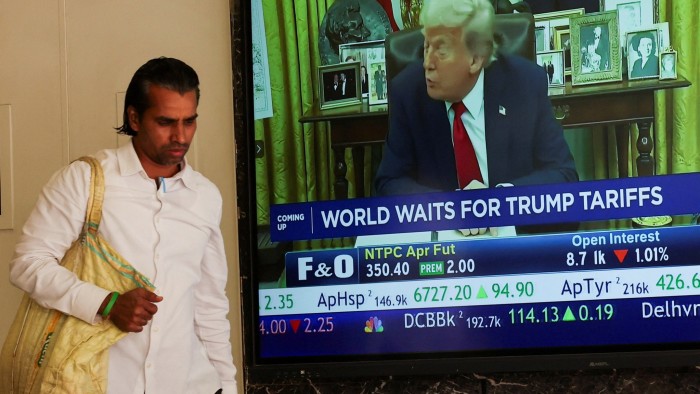Good morning. Stock markets around the world are still struggling to make sense of US President Donald Trump’s tariffs. Indian markets are also waiting for the Reserve Bank of India’s interest rate announcement tomorrow. We will keep an eye.
India’s southern states are anxious because a freeze on delimitation expires next year, which could result in their representation in the parliament falling. But first, is the golden age of India’s IT sector over?
Indian IT needs a reboot
The IT services sector, once a bellwether of India’s stock markets, simply can’t seem to catch a break. Major stocks including Infosys, HCL Technologies and Tech Mahindra were already relatively muted during the big bull run of the past two years. They are now also some of the worst affected by Trump’s tariffs. The three stocks closed at 1,405 (-3.22%), 1,378 (-3.1%) and 1,293 (-2.12%) respectively, yesterday.
HSBC expects Infosys and HCLTech to announce growth guidance of only 2 to 5 per cent for this fiscal year. If US market sentiment improves, the two Indian groups could touch the upper end of this range, the bank said in a report last week. For the sector as a whole, HSBC expects 7 to 9 per cent growth in earnings per share in the next two years. But brokerages already had tepid outlooks long before Trump’s announcements last week.
The outsourcing model adopted by big Indian groups offering technology services now faces several challenges. The US makes up at least 50 per cent of the client base for these companies. If Trump’s trade war pushes the American economy into a recession, large US corporations will tighten their belts and not immediately invest in expanding their IT capabilities. This will hit order books here. On top of that, the Indian model hinges on sending software engineers from India to overseas client sites for projects. This could take a big hit from “America First” policies, should the US slash the number of H-1B visas for foreign skilled workers.
Another major problem for the sector are so-called global capability centres, or GCCs. More large multinational corporations have been opening and operating these centres in India in the past few years, as they cut back on outsourcing certain business functions. GCCs give them the benefits of offshoring (or nearshoring) while keeping it in-house, ensuring control. Indian tech groups, which have focused largely on expansion, have not built a moat around their business model — making them easy to replace now.
In a poll that we ran in India Business Briefing on March 25, some 59 per cent of readers said they were looking to buy the dips in the market in the tech sector. But last week’s events will prolong the uncertainty around these stocks, even before we consider other strong headwinds. One example is artificial intelligence: models that can write complex code will probably replace many human software engineers soon. By all indications, the golden age of Indian outsourcing seems to be over.
Do you think Indian IT will find its mojo again? Hit reply or write to us at indiabrief@ft.com
Recommended stories
-
From cars with roof-fitted drones to free self-driving software and five-minute battery charges, China’s pace of electric vehicle innovation has been rapid.
-
Peter Navarro, Trump’s senior trade adviser, writes in today’s FT: “President Trump is simply charging you what you are charging us. What is fairer than that?”
-
Trump’s press secretary has touted him as “negotiator-in-chief”. What business lessons can we draw from his dealmaking style?
-
Starbucks is slowing its India expansion as consumer spending shrinks.
-
Our latest Big Read asks: how do we restore trust in doctors in an age of misinformation.
South vs North
Next year, a 25-year freeze on “delimitation” will lapse, which means the government will be able to change how states are represented in parliament to reflect shifts in the population.
This prospect has the more prosperous and less populous southern states worried. Political tensions with the largely BJP-ruled north are already high, with redistribution of tax the central flashpoint. The union government often invokes an “equity principle” in determining how tax revenues are distributed to each state, which results in the north getting more money than it makes. For every rupee that Tamil Nadu sends to the centre, it now gets only 30 paise back, while Uttar Pradesh gets Rs3.
The delimitation exercise is provided for in the constitution, but has always been a thorny issue and successive governments have chosen to postpone it. Parliamentary seats were last apportioned in 1973 when India’s population was 548mn.
A population-based reapportionment of seats in 2026 could see the southern states lose up to 26 seats in the lower house. While the principle behind the idea of proportional representation is sound, India’s lopsided economic development makes this an unfair exercise. In essence, the southern states, which have better social and economic development indicators and lower population growth, will be punished for their success.
The political slugfest that has already begun is dredging up many deep-seated and divisive societal issues. These tensions will only rise in the following months. The question is whether Modi’s coalition government thinks this political and social instability is worth the eventual pay-off. It is a temptation that his BJP will find hard to resist.
Go figure
We’ll stick to the stock markets here for another edition, as reactions to Trump’s tariffs continue. On Friday and yesterday, India fell less than other markets around the world.
My mantra
“Before a major project or investment, I like to think about the pre-mortem — if things don’t work out, what could be the main reasons? It allows me to focus on the most important risk mitigants, as opposed to reacting to point-in-time situations.”
Harshjit Sethi, managing director, Peak XV (formerly Sequoia India)

Each week, we invite a successful business leader to tell us their mantra for work and life. Want to know what your boss is thinking? Nominate them by replying to indiabrief@ft.com
Quick question
What do you think of Trump’s tariffs: sheer genius or complete insanity? Take part in our poll, here.

Buzzer round
On Friday we asked: Which Hong Kong-based company, founded as an opium trader in the 1800s, inspired a novel that was made into a movie starring Pierce Brosnan?
The answer is . . . Jardine Matheson.
Many of you wrote in with the right answer. (And yes, Noble House was a series, not a movie. My mistake.) Several people also came very close to being the fastest, among them Pratik Rangnekar, Gulu Lalvani, Yaman Singhania and Padmanabha Mishra. Thank you all for participating.
But reigning Buzzer Round champion Aniruddha Dutta remains unbeaten. For his long-running speed and accuracy, we sent him a little goodie bag!

Thank you for reading. India Business Briefing is edited by Tee Zhuo. Please send feedback, suggestions (and gossip) to indiabrief@ft.com.
Source link









